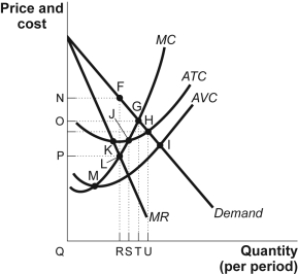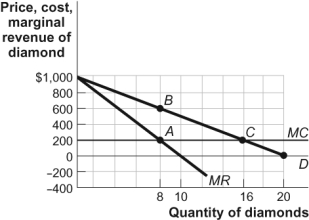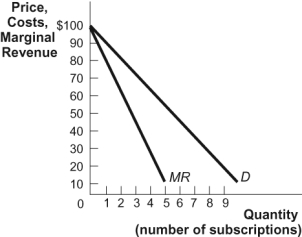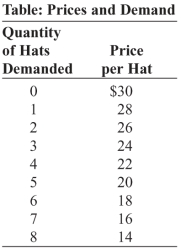Correct Answer

verified
Correct Answer
verified
Multiple Choice
Most electric, gas, and water companies are examples of:
A) unregulated monopolies.
B) natural monopolies.
C) restricted-input monopolies.
D) sunk-cost monopolies.
Correct Answer

verified
Correct Answer
verified
Multiple Choice
Use the following to answer questions
Figure: Short-Run Monopoly  -(Figure: Short-Run Monopoly) Look at the figure Short-Run Monopoly. The marginal cost of producing the profit-maximizing quantity is cost:
-(Figure: Short-Run Monopoly) Look at the figure Short-Run Monopoly. The marginal cost of producing the profit-maximizing quantity is cost:
A) N.
B) O.
C) P.
D) Q.
Correct Answer

verified
Correct Answer
verified
True/False
When a monopolist practices price discrimination as opposed to setting a single price, the monopolist increases its profits by capturing consumer surplus.
Correct Answer

verified
Correct Answer
verified
Multiple Choice
Use the following to answer questions:
Figure: The Profit-Maximizing Output and Price  -(Figure: The Profit-Maximizing Output and Price) Look at the figure The Profit-Maximizing Output and Price. Assume that there are no fixed costs and AC = MC = $200. At the profit-maximizing output and price for a perfectly competitive industry, deadweight loss is:
-(Figure: The Profit-Maximizing Output and Price) Look at the figure The Profit-Maximizing Output and Price. Assume that there are no fixed costs and AC = MC = $200. At the profit-maximizing output and price for a perfectly competitive industry, deadweight loss is:
A) $0.
B) $200.
C) $1,600.
D) $3,200.
Correct Answer

verified
Correct Answer
verified
Multiple Choice
Use the following to answer questions:
Figure: PPV  -(Figure: PPV) Look at the figure PPV, which shows the demand and marginal revenue for a pay-per-view football game on cable TV. Assume that the marginal cost and average cost are a constant $40. If the cable company practices perfect price discrimination, consumer surplus will be:
-(Figure: PPV) Look at the figure PPV, which shows the demand and marginal revenue for a pay-per-view football game on cable TV. Assume that the marginal cost and average cost are a constant $40. If the cable company practices perfect price discrimination, consumer surplus will be:
A) $180.
B) $100.
C) $40.
D) $0.
Correct Answer

verified
Correct Answer
verified
Multiple Choice
Mr. Porter sells 10 bottles of champagne per week at $50 per bottle. He can sell 11 bottles per week if he lowers the price to $45 per bottle. The quantity and the price effects on total revenue would be, respectively, an increase of _____ and a decrease of _____.
A) $450; $500
B) $495; $550
C) $45; $5
D) $45; $50
Correct Answer

verified
Correct Answer
verified
True/False
Monopoly is inefficient because some consumer surplus is transferred to producer surplus.
Correct Answer

verified
Correct Answer
verified
Multiple Choice
Use the following to answer questions:
Figure: The Profit-Maximizing Output and Price  -(Figure: The Profit-Maximizing Output and Price) Look at the figure The Profit-Maximizing Output and Price. Assume that there are no fixed costs and AC = MC = $200. At the profit-maximizing output and price for competitor perfectly competitive industry, consumer surplus is:
-(Figure: The Profit-Maximizing Output and Price) Look at the figure The Profit-Maximizing Output and Price. Assume that there are no fixed costs and AC = MC = $200. At the profit-maximizing output and price for competitor perfectly competitive industry, consumer surplus is:
A) $0.
B) $6,400.
C) $1,600.
D) $3,200.
Correct Answer

verified
Correct Answer
verified
Multiple Choice
The demand curve facing a monopolist is:
A) horizontal, the same as that facing a perfectly competitive firm.
B) downward-sloping, the same as that facing a perfectly competitive firm.
C) upward-sloping, the same as that facing a perfectly competitive firm.
D) downward-sloping, unlike the horizontal demand curve facing a perfectly competitive firm.
Correct Answer

verified
Correct Answer
verified
Multiple Choice
You own a lemonade stand in a competitive market, and as such, you are a price-taking firm. Which of the following events would most likely increase your market power?
A) The government abolishes the system of patents and copyrights.
B) A booming economy increases the demand for lemonade and attracts entry into the market.
C) The average total cost curve for firms in the industry is horizontal.
D) You own exclusive rights to harvest lemons from all domestic citrus orchards.
Correct Answer

verified
Correct Answer
verified
Multiple Choice
In monopoly:
A) a basic condition for efficiency is violated because P > MC.
B) consumers are confronted with a price that is lower than marginal cost.
C) consumers will buy more of the good than is economically efficient.
D) consumers are confronted with a price that is lower than average total cost.
Correct Answer

verified
Correct Answer
verified
Multiple Choice
Airlines that engage in price discrimination charge higher prices to business travelers because their _____ is more _____ than that of other travelers.
A) demand; elastic
B) demand; inelastic
C) supply; elastic
D) supply; inelastic
Correct Answer

verified
Correct Answer
verified
Multiple Choice
Use the following to answer questions:  -(Table: Prices and Demand) The New Orleans Saints have a monopoly on Saints logo hats. The marginal cost of producing a hat is $18. If the Saints increase the number of hats they sell from four to five, the price effect is a(n) _____ in total revenue of _____.
-(Table: Prices and Demand) The New Orleans Saints have a monopoly on Saints logo hats. The marginal cost of producing a hat is $18. If the Saints increase the number of hats they sell from four to five, the price effect is a(n) _____ in total revenue of _____.
A) decrease; $20
B) increase; $20
C) decrease; $8
D) increase; $8
Correct Answer

verified
Correct Answer
verified
Multiple Choice
When a monopolist practices price discrimination, compared to a single-price monopolist, deadweight loss will:
A) remain the same.
B) increase.
C) decrease.
D) increase initially, and then return to its original level.
Correct Answer

verified
Correct Answer
verified
Multiple Choice
An oligopoly is characterized as an industry in which:
A) there are few firms, each producing a differentiated or similar product.
B) there are many firms, each producing a similar product.
C) all market participants are price takers.
D) only one firm produces a very differentiated product.
Correct Answer

verified
Correct Answer
verified
Multiple Choice
Use the following to answer questions:  -(Table: Prices and Demand) Look at the table Prices and Demand. The New Orleans Saints have a monopoly on Saints logo baseball hats. The Saints sell at most one hat to each customer, and the table shows each customer's willingness to pay. The marginal cost of producing a hat is $18, and there are no fixed costs. How much is the Saints' profit at the profit-maximizing output?
-(Table: Prices and Demand) Look at the table Prices and Demand. The New Orleans Saints have a monopoly on Saints logo baseball hats. The Saints sell at most one hat to each customer, and the table shows each customer's willingness to pay. The marginal cost of producing a hat is $18, and there are no fixed costs. How much is the Saints' profit at the profit-maximizing output?
A) $24
B) $18
C) $12
D) $30
Correct Answer

verified
Correct Answer
verified
Multiple Choice
In contrast with perfect competition, a monopolist:
A) produces more at a lower price.
B) produces where MR > MC, and a perfectly competitively firm produces where P = MC.
C) may have economic profits in the long run.
D) earns zero economic profits in the long run.
Correct Answer

verified
Correct Answer
verified
True/False
A monopolist that charges each customer a different price based on the customer's individual willingness to pay is called a single-price monopolist.
Correct Answer

verified
Correct Answer
verified
Multiple Choice
Use the following to answer questions:
Figure: PPV  -(Figure: PPV) Look at the figure PPV, which shows the demand and marginal revenue for a pay-per-view football game on cable TV. Assume that the marginal cost and average cost are a constant $40. If the cable company practices perfect price discrimination, deadweight loss will be:
-(Figure: PPV) Look at the figure PPV, which shows the demand and marginal revenue for a pay-per-view football game on cable TV. Assume that the marginal cost and average cost are a constant $40. If the cable company practices perfect price discrimination, deadweight loss will be:
A) $180.
B) $100.
C) $40.
D) $0.
Correct Answer

verified
Correct Answer
verified
Showing 201 - 220 of 348
Related Exams